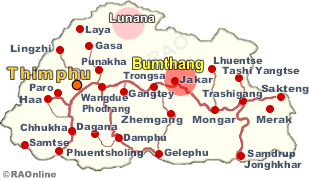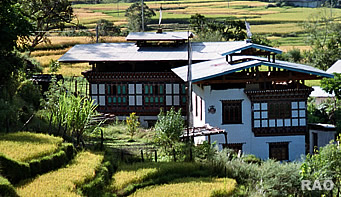 |
Bhutan's
Economy: Agriculture |
|
 |
Bhutan Information |
|
|
 |
|
Bumthang:
Paddy Cultivation
|
 |
 |
| In
autumn 2004 when Doepola from Changwa in Bumthang harvested paddy from
his once marshy field he was on the verge of tears. It was the first time
his marshy expanse had yielded rice.
"I
offered some of the harvest to the various lhakhangs in the valley," said
the 65-year-old farmer. "I never thought rice cultivation would work in
Bumthang. It was tried a number of times before but it was not successful." |
|
"I
offered some of the harvest to the various lhakhangs in the valley," said
the 65-year-old farmer. "I never thought rice cultivation would work in
Bumthang. It was tried a number of times before but it was not successful."
| Ap
Doepola tends to his paddy seedlings |
|
Doepola
is one of the farmers from the four villages under Choekhor and Tang
geog who volunteered to cultivate paddy on a large scale in 2004 following
the successful trials of the Paro-China rice variety in 11 villages by
the Renewable Natural Resources- Research Centre in Jakar.
This
spring, Doepola is all eager for his second cultivation as he and his wife
happily weed the row of paddy seedlings in the garden outside their house
which will be transplanted in the last week of April. "I am happy that
I decided to cultivate rice," said Doepola. "I can use the proceeds from
the sale of potatoes for buying other basic goods and still have rice to
eat."
|
|
 |
Doepola's
half an acre land yielded about 800 kilogrammes of rice last year. "Before
it was only on special occasions such as losar and tshechus that we bought
red rice," he said.
According
to the RNR RC program director, Kinzang Wangdi, the farmers are provided
with technical support and seedlings in the first year and are expected
to take over from the second year, which includes raising their own seedlings.
This
year, the number of farmers volunteering to cultivate paddy has increased
to 27 from 19 last year. Three farmers are expanding the area under paddy
cultivation. In total 15.5 acres of land in seven villages under the two
geogs will be cultivated. "About 75 percent of the land under paddy cultivation
was marshy, the rest were kept fallow," said Kinzang Wangdi. "Water was
drained out of the marshy fields by drainage channels which were constructed
with the help from the central machinery unit."
Last
year the farmers had proposed cultivating paddy in an additional 15.56
acre area to the already existing eight acres but the proposal was shelved
based on a feasibility study, research centre officials said.
The
feasibility study looked at whether the land had irrigation, was suitable
for mechanisation and was marshy or waste land so that the potato cultivation
is not disturbed. It also required the land to be away from forest or shady
areas since paddy is very sensitive to shade.
 |
|
Punakha
Valley and Mo Chhu
|
The
research centre tried and tested 18 varieties of paddy including four traditional
and 14 exotic varieties like Chumro and Hayana Sari since 1997 at the on-station
plot and in farmer's fields at 2,600 to 2,700 meters above sea level. The
Paro-China variety was found to be most suitable in terms of yield, milling
recovery and time taken to mature from the two varieties that performed
well under the Bumthang's cool temperate conditions. Research officials
said that unlike the paddy fields in the southern foothills, paddy fields
in Bumthang required standing water to boost the temperature. "The water
absorbs the heat from the sun and keeps the temperature higher by two degree
Celsius compared with that of air," said Kinzang Wangdi.
 |
| Mo Chhu Valley, Punakha |
| The
idea behind initiating paddy cultivation is to help develop food sufficiency
and in the process also reclaim unproductive marshy lands research officials
said. The marshy areas were also no good to cultivate potatoes, Bumthang's
main cash crop.
"One
of the long term goals of initiating rice cultivation in Bumthang is to
capture a niche market by producing organic rice," said Kinzang Wangdi." |
|
Paddy farmers are advised not to use inorganic or chemical fertilizers."
Farmer
Pema Choden, also from Changwa village had low yield last year but this
year she has extended the area for paddy cultivation. "Last year the seedlings
were transplanted late, this time I am hoping to do everything right,"
she said.
| Contributed
by Rinzin Wangchuk, KUENSEL, Bhutan's National Newspaper
2005 |
 |
 |
|
Bumthang
|
| Information on Bhutan |
 |
|







